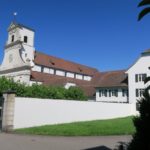During the reign of Emperor Claudius (41-54 AD), Martigny, a small village of the Celtic tribe of the Veragres, was turned into a Roman city.
When he became emperor, the emperor undertook the conquest of Britain. He made accessible the most direct route to Britain: the Great St Bernard Pass. At the same time, he reorganised the Valais. The capital was a newly founded city at the foot of the pass. He named it Forum Claudii Augusti, which later became Forum Claudii Valensium, today’s Martigny. It was also one of the two residences of the governor of the Roman province of Alpes Graiae.

The city was built based on the Roman grid system, formed by three series of five insulae, districts for poor inhabitants. These residential blocks were separated by wide avenues.
In the centre were the forum, the temple, the basilica, the public baths and other public buildings.
The amphitheatre was built in the early 2nd century near the quarry for its construction.
The amphitheatre was used until the end of the 4th century. It could accommodate 5000 spectators. The walls have been restored to their former glory.
(Source and further information: www.martigny.ch; F. Wiblé, Martigny-la-Romaine, Fondation Pierre Gianadda, Martigny 2008; F. Wiblé e.a., Vallis Poenina, Sitten, 1998; Fondation Pierre Gianadda)
See also: the Fondation Barry and the Médiathèque Valais



Collection: Fondation Pierre Gianadda. Photo: TES

Reconstruction of the Forum and Roman city. Collection: Fondation Pierre Gianadda.


The ancient Via Rome-London

The Mithraeum temple

The Domus Minerva

The location of the Roman thermes

Martigny, copie of a masque from the Roman theatre of romain de Vaison-la-Romaine (France)

The Tepidarium

One of the Insulas
Impression of the amphitheatre








Impressions of Martigny


The old town

The Bâtiaz bridge (Le pont de Bâtiaz)

Bâtiaz Castle (Château de la Bâtiaz)


The church Saint-Michel



Napoleon and his generals stayed in these houses upon their crossing of the Grand-Saint-Bernard.


Napoleon on the Grand-Saint-Bernard

The main square in the city centre


The town hall



The church Notre-Dame de la Visitation


The moulin (mill) Semblanet and the museum

The Manoir de la ville
































































